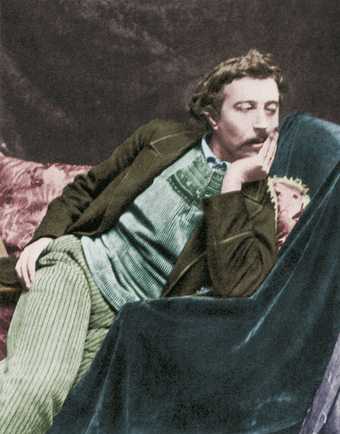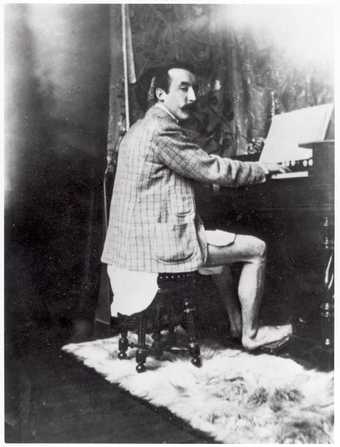In February 1888, on the second of his several visits to Brittany, Gauguin wrote a letter to his painter friend Émile Schuffenecker in Paris. It is a much-quoted text – and understandably so – for it seems to encapsulate the artist’s interest in the northern area of France. For Gauguin, this region offered an immediate appeal to the senses, but also a promise of hidden depths: his journey to this place, like his travels to more far-flung destinations, would facilitate a voyage of self-discovery. 'Here I find a savage, primitive quality,' he explained. 'When my wooden shoes echo on this granite ground, I hear the dull, muted, powerful sound I am looking for in painting.' This place was famed for its harsh and changeable weather, its old-fashioned way of life, its unusual practice of Catholicism. It was, in so many ways, a taste of the exotic that was relatively close to home. A fourteen-hour train journey from Paris took travellers to the town of Quimperlé; from there, with a horse and trap, an artist might reach the market town of Pont-Aven with ease, where he could live conveniently and work in peace. In theory, at least, Brittany was far away from the trappings of modern life; and what signs of “civilisation” there were could be easily ignored for the sake of art.
This is not to say, however, that the region had not drawn Gauguin for more prosaic reasons. When he first moved to Pont-Aven in 1886, it was some four years since he had given up a well-paid job in the city, to try to make a living as a professional artist. When his initial efforts proved unsuccessful, he had moved his family to Rouen in 1884: a difficult spell ensued that eventually resulted in his wife Mette and their children moving back to her native Copenhagen. By now Gauguin was in dire financial straits and had few friends in Paris. Pont-Aven, in contrast, offered low-cost living and an established artistic community where he might meet like-minded peers. Certainly, the first of these considerations was enough to draw him, and the second (even if he had not been aware of its extent at the time of his move) would provide him with the flattery that his bruised ego surely craved. That June, soon after his arrival, he reported to his wife that his painting was attracting considerable attention and that he was hopeful for the future. By July, he felt confident enough to boast that he was the most respected artist in the town, and told how all around seemed to be vying for his advice, which he was 'stupid enough to give'.
Surprisingly, perhaps, the artist did not produce any major paintings on his first Breton trip. Instead, he made sketches, and gained assurance from the considerable peer-group recognition. Most of the painters working in Pont-Aven produced scenes with conventional colouration, rendered in painstaking brushwork and imbued with moral or sentimental overtones. The area was picturesque and, for many years, city dwellers had enjoyed the scenes of idyllic or pious rural life that were sent to the annual Salon in the French capital. Gauguin, who had by now already exhibited with the Impressionists for several years, offered a far more daring formal approach. It is easy to imagine the impact he made at the Pension Gloanec – the cheap guesthouse that he made his home – with its mixed company of French and foreign artists. As one visitor to the area in 1879 had described, in contrasting this location with the two more established (and expensive) hotels in the town centre, this was 'the true home of Bohemia' in Pont-Aven. The walls of the rooms were decorated with works of art and outside, morning and evening alike, artists sat around a table on the street, 'dressed like middle-class country-folk'. Marie-Jeanne, who ran the establishment with her husband Joseph, was resourceful enough to arrange for artists to stay in rooms elsewhere in the town too, so in the summer when the students from the Paris art schools descended, the pension could have as many as 50 or 60 guests.
Gauguin, like most of the painters who came to Brittany, was drawn to the distinctive costume worn by the local women – their angular headdresses in particular – and ancient Celtic customs such as wrestling. But his use of those motifs would be exceptional. This much is evident from an important painting he made on his second visit to the region, the striking Vision of the Sermon, which he made in 1888, perhaps under the influence of the painter Emile Bernard (who was also resident at the pension). It was usual for young boys to participate in the 'Gouren' – a type of ritual combat – after mass on religious feast days. Protagonists made the sign of the cross and renounced the devil before the fight began, and the winner might walk away with a prized animal. It is likely, then, that Gauguin had this in mind when he placed a cow to the left of the steeply slanted tree and figures in his bold composition. But the men themselves are no longer local boys: they are Jacob and the Angel, from the sermon given in the service. And the women watching are no longer supporters who shout encouragement to their contender. Some are lost in prayer; others stare with trance-like intensity. The 'vision', explained Gauguin, was theirs: hence the disparate scale of the different elements of the image. The silhouettes of the faithful stand sharp against the intense red landscape. It is perhaps unsurprising that the canvas was rejected by a local priest when the artist offered it to the church, but it does not necessarily mean that the offer was insincere. Despite his alternative lifestyle, Gauguin held a deep interest in spirituality, and was drawn to write on Catholicism in his later years.
It was in 1889, during a third stay, that the painter finally responded to Breton art in his own work. It was then that he began work on his Yellow Christ and his Green Christ: paintings that provide a perfect demonstration of the formal qualities that the artist sought (and would continue to seek) in his work. Even on this occasion, however, there was more to this period of creativity than drawing from new visual inspiration. In Brittany, as in overseas locations, Gauguin adapted motifs, combined references, and imbued his images with personal meaning. To compare the canvases with photographs of their evident sources of inspiration – a fifteenth-century polychrome wooden crucifix housed in the chapel at Trémalo, near to Pont-Aven, and the Calvaire (Calvary) sculpture outside the church at Nizon – is to see how Gauguin transformed the things he saw to suit his purposes. Most strikingly of all, perhaps, he valued flatness. In adapting three-dimensional statues to two-dimensional surfaces, he did away with any sense of shadows that might project perspectival depth, replacing them with unforgiving lines. In both instances, he outlined the body of Christ in a similarly stark fashion, confusing its relationship with the wooden cross in Yellow Christ, or flattening it against its fellow stone figures in Green Christ. He even went so far as to blot the surfaces of certain canvases with newspaper, perhaps to create a matt effect, for traces of print are evident in the paint on Yellow Christ. The imagery in these works may be Breton, but Gauguin insisted on making it his own.
Yellow Christ, in particular, had a strong personal resonance for the painter. He went on to include it in the background to one of his most striking self-portraits, developing a favoured analogy between his own creative suffering and the agony of Christ: a theme he would also explore in his Christ in the Garden of Olives of the same year. In both canvases, Christ shares a certain turn of the head; theirs are the same heavy eyelids and straight-set nose. And both seem set apart from their surroundings. The kneeling women in Yellow Christ appear uprooted or weightless; they float against their setting of fields and hills, distant from the Calvary they worship. In both scenes, figures flee from the subject of the picture. It was perhaps with these two images in mind – and Gauguin’s identification with Christ – that the writer Octave Mirbeau, a supporter of the painter and his work, assessed Yellow Christ in 1891. Mirbeau contrasted its 'pitiful and barbaric' protagonist to the indifference of his worshippers: a slight too, perhaps, on the public who failed to understand the suffering artist. “They have come because it is their custom to come, on the day of a Pardon. But their eyes and their lips are empty of prayers. They don’t spare a thought for, or glance at, the image of the One who died for love of them. Already, hurdling over the hedges and fleeing beneath the red apple trees, other peasants hurry home, happy to be done with their devotion. And the melancholy of this wooden Christ is unspeakable…, he seems to say to himself in seeing this wretched, uncomprehending humankind at his feet, ‘and now what, if my sacrifice was in vain?'
Comparably, it is clear from his letters that Gauguin wondered if his endeavours would ever gain recognition. But they also show stubborn determination and remarkable self-confidence. Unlike a Christ who suffered in silence, Gauguin included these images of agony in a highly publicised auction, held in February of 1891, that helped him to promote his efforts and, more importantly, secured the financial backing he needed for further travels. Brittany facilitated his creative journey doubly, then, in ways that were both mystical and practical.



